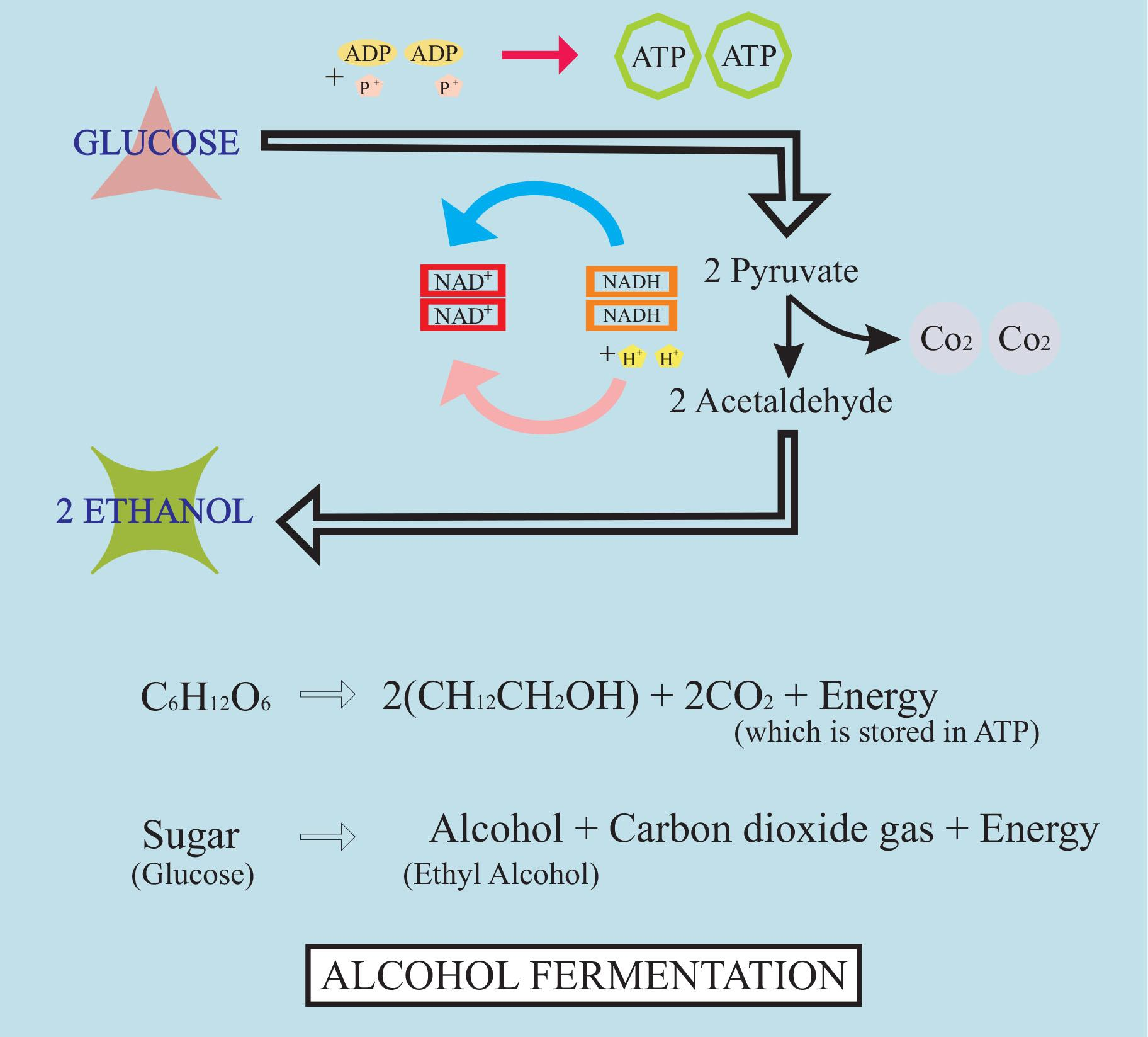
Of the following, the end product of fermentation is
(a)${ O }_{ 2 }$
(b)${ N }_{ 2 }{ O }_{ 2 }$
(c)${ H }_{ 2 }O$
(d)${ C }_{ 2 }{ H }_{ 5 }OH$
Answer
548.7k+ views
Hint: Fermentation is the process of breaking organic compounds to release energy in the absence of oxygen with the release of alcohol or lactic acid depending on the enzyme catalyzing the reaction. This process is utilized by humans to produce a desirable food product of beverage.
Complete answer:
Fermentation takes place in the body when there are anaerobic conditions present to still keep supplying energy by the incomplete oxidation of organic substances. Very little energy is trapped during fermentation, less than 7% of the energy in glucose. Fermentation is of two types known as lactic acid fermentation and alcoholic fermentation. Lactic acid fermentation takes place in some bacteria and our muscles where the enzyme lactate dehydrogenase acts on pyruvate to produce lactic acid. Alcohol fermentation takes place in yeast where the enzymes pyruvic acid decarboxylase and alcohol dehydrogenase act as pyruvic acid to produce ${ CO }_{ 2 }$ and ethanol.
Additional Information: Let us learn more about respiration. Respiration is the process of breaking the C-C bonds of organic substances to release energy inside a cell.
Glycolysis: Glucose (most favored substrate for respiration) is broken down into two molecules of pyruvic acid and it takes place in the cytoplasm.
Link reaction: In this reaction, pyruvic acid is transported into the mitochondria and converted into acetyl CoA with the release of carbon dioxide.
Kreb’s cycle: Krebs cycle takes place in the matrix of the mitochondria where energy intermediates ${ NADH }_{ 2 }$ and ${ FADH }_{ 2 }$ are formed along with ATP.
Electron transport system (ETS): There is a system of electron carriers located on the inner membrane of the mitochondria which help in converting the energy of the energy intermediates into ATP and this process is known as oxidative phosphorylation.
So, the correct option is ‘${ C }_{ 2 }{ H }_{ 5 }OH$’.
Note: -Compounds like alcohol are toxic and thus yeast poison themselves when the concentration of alcohol reaches 13 percent during fermentation.
-Alcoholic beverages with a concentration greater than 13% are obtained with the help of distillation.
-Aerobic respiration is the complete oxidation of organic substances to release a large amount of energy in the presence of oxygen.

Complete answer:
Fermentation takes place in the body when there are anaerobic conditions present to still keep supplying energy by the incomplete oxidation of organic substances. Very little energy is trapped during fermentation, less than 7% of the energy in glucose. Fermentation is of two types known as lactic acid fermentation and alcoholic fermentation. Lactic acid fermentation takes place in some bacteria and our muscles where the enzyme lactate dehydrogenase acts on pyruvate to produce lactic acid. Alcohol fermentation takes place in yeast where the enzymes pyruvic acid decarboxylase and alcohol dehydrogenase act as pyruvic acid to produce ${ CO }_{ 2 }$ and ethanol.
Additional Information: Let us learn more about respiration. Respiration is the process of breaking the C-C bonds of organic substances to release energy inside a cell.
Glycolysis: Glucose (most favored substrate for respiration) is broken down into two molecules of pyruvic acid and it takes place in the cytoplasm.
Link reaction: In this reaction, pyruvic acid is transported into the mitochondria and converted into acetyl CoA with the release of carbon dioxide.
Kreb’s cycle: Krebs cycle takes place in the matrix of the mitochondria where energy intermediates ${ NADH }_{ 2 }$ and ${ FADH }_{ 2 }$ are formed along with ATP.
Electron transport system (ETS): There is a system of electron carriers located on the inner membrane of the mitochondria which help in converting the energy of the energy intermediates into ATP and this process is known as oxidative phosphorylation.
So, the correct option is ‘${ C }_{ 2 }{ H }_{ 5 }OH$’.
Note: -Compounds like alcohol are toxic and thus yeast poison themselves when the concentration of alcohol reaches 13 percent during fermentation.
-Alcoholic beverages with a concentration greater than 13% are obtained with the help of distillation.
-Aerobic respiration is the complete oxidation of organic substances to release a large amount of energy in the presence of oxygen.

Recently Updated Pages
Master Class 12 Business Studies: Engaging Questions & Answers for Success

Master Class 12 Economics: Engaging Questions & Answers for Success

Master Class 12 English: Engaging Questions & Answers for Success

Master Class 12 Maths: Engaging Questions & Answers for Success

Master Class 12 Social Science: Engaging Questions & Answers for Success

Master Class 12 Chemistry: Engaging Questions & Answers for Success

Trending doubts
What is meant by exothermic and endothermic reactions class 11 chemistry CBSE

Which animal has three hearts class 11 biology CBSE

10 examples of friction in our daily life

One Metric ton is equal to kg A 10000 B 1000 C 100 class 11 physics CBSE

1 Quintal is equal to a 110 kg b 10 kg c 100kg d 1000 class 11 physics CBSE

Difference Between Prokaryotic Cells and Eukaryotic Cells




